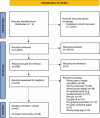Measuring sleep health in primary school-aged children: A systematic review of instruments and their content validity
- PMID: 36087112
- PMCID: PMC9644118
- DOI: 10.1093/sleep/zsac215
Measuring sleep health in primary school-aged children: A systematic review of instruments and their content validity
Abstract
Study objectives: This review aimed to summarize instruments that measure one or more domains of sleep health (i.e. duration, quality, efficiency, timing, daytime sleepiness and sleep-related behaviors) in a general population of 4-12-year old children, and to assess these instruments' content validity. Other measurement properties were evaluated for instruments with indications of sufficient content validity.
Methods: A systematic literature search was performed in PubMed, PsycINFO, Web of Science, and EmBase. Methodological quality, content validity, and other measurement properties were assessed via the COnsensus-based Standards for the selection of health Measurement INstruments (COSMIN) methodology. Instruments with indications of sufficient content validity (i.e. relevance, comprehensiveness and comprehensibility) were further evaluated on other measurement properties (i.e. other aspects of validity, reliability, responsiveness). A modified GRADE approach was applied to determine the quality of evidence.
Results: Twenty instruments, containing 36 subscales, were included. None of the instruments measured all sleep health domains. For five (subscales of) instruments sufficient relevance and comprehensibility was found. The quality of evidence ranged from very low to moderate. For these five instruments all additional measurement properties were assessed. Sufficient results were found for structural validity (n = 1), internal consistency (n = 1), and construct validity (n = 1), with quality of evidence ranging from very low to high.
Conclusions: Several (subscales of) instruments measuring domains of child sleep health showed good promise, demonstrating sufficient relevance, comprehensibility, and some also sufficient results on other measurement properties. However, more high quality studies on instrument development and the evaluation of measurement properties are required.PROSPERO registration number: CRD42021224109.
Keywords: COSMIN; children; measurement properties; questionnaires; sleep.
© Sleep Research Society 2022. Published by Oxford University Press on behalf of the Sleep Research Society.
Similar articles
-
Psychometric properties of instruments for measuring abuse of older people in community and institutional settings: A systematic review.Campbell Syst Rev. 2024 Aug 29;20(3):e1419. doi: 10.1002/cl2.1419. eCollection 2024 Sep. Campbell Syst Rev. 2024. PMID: 39211334 Free PMC article. Review.
-
Falls efficacy instruments for community-dwelling older adults: a COSMIN-based systematic review.BMC Geriatr. 2021 Jan 7;21(1):21. doi: 10.1186/s12877-020-01960-7. BMC Geriatr. 2021. PMID: 33413136 Free PMC article.
-
Instruments assessing medication literacy in adult recipients of care: A systematic review of measurement properties.Int J Nurs Stud. 2021 Jan;113:103785. doi: 10.1016/j.ijnurstu.2020.103785. Epub 2020 Oct 2. Int J Nurs Stud. 2021. PMID: 33080478
-
Measuring situation awareness in health care providers: a systematic review of measurement properties using COSMIN methodology.Syst Rev. 2023 Apr 1;12(1):60. doi: 10.1186/s13643-023-02220-6. Syst Rev. 2023. PMID: 37005682 Free PMC article.
-
Measurement properties of Patient-Reported Outcome Measures used to assess the sleep quality in adults with high prevalence chronic pain conditions: a systematic review.Sleep Med. 2020 Oct;74:315-331. doi: 10.1016/j.sleep.2020.06.028. Epub 2020 Jul 2. Sleep Med. 2020. PMID: 32890946
Cited by
-
Measures of Sleep-Related Fears in Children: A Systematic Review of Psychometric Properties Using COSMIN.Clin Child Fam Psychol Rev. 2025 Jun;28(2):439-457. doi: 10.1007/s10567-025-00526-6. Epub 2025 May 21. Clin Child Fam Psychol Rev. 2025. PMID: 40397330 Free PMC article.
-
Agreement between parental reports and accelerometer measures of sleep duration in primary school children.Sci Rep. 2025 Jul 15;15(1):25654. doi: 10.1038/s41598-025-07786-w. Sci Rep. 2025. PMID: 40664721 Free PMC article.
-
Covariance patterns between sleep health domains and distributed intrinsic functional connectivity.Nat Commun. 2023 Nov 6;14(1):7133. doi: 10.1038/s41467-023-42945-5. Nat Commun. 2023. PMID: 37932259 Free PMC article.
-
COSMIN guideline for systematic reviews of patient-reported outcome measures version 2.0.Qual Life Res. 2024 Nov;33(11):2929-2939. doi: 10.1007/s11136-024-03761-6. Epub 2024 Aug 28. Qual Life Res. 2024. PMID: 39198348 Free PMC article.
-
Assessing sleep behaviors in Latino children and adolescents: what is known, what are we missing, and how do we move forward?Curr Opin Pediatr. 2024 Feb 1;36(1):17-22. doi: 10.1097/MOP.0000000000001306. Epub 2023 Nov 7. Curr Opin Pediatr. 2024. PMID: 37933679 Free PMC article. Review.
References
-
- Taras H, et al. . Sleep and student performance at school. J School Health 2005;75(7):248–254. - PubMed


